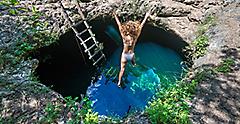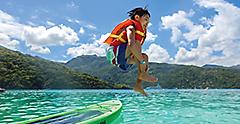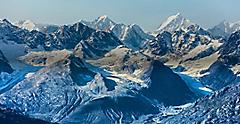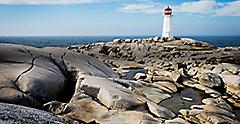
America’s Last Frontier is a land of endless new discoveries, breathtaking landscapes, and off-the-beaten-path trails that lead to bucket list adventures. From glacier gazing and wildlife watching to catching a glimpse of the elusive Northern Lights, you’ll find plenty of ways to fill your days with awe-inspiring thrills. But like many of the world’s most incredible destinations, figuring out the best time to visit Alaska depends a lot on which experiences interest you. And with cruise itineraries that run from spring to the start of fall, getting there is easy.
IF YOU WANT TO HIT THE TRAILS
Planning to take advantage of Alaska’s rugged terrain and untamed hiking paths? With so much to see, you’ll want a lot of daylight to maximize your time spent ashore. Days in Alaska are longest throughout the month of June, sometimes reaching close to 20 hours of sunlight. That’s plenty of light to explore the vast seaside plains, glacier-dotted bays, lush alpine forests, and misty mountain-flanked fjords you’ll encounter while traveling from one incredible port to another. Temperatures are warmest in the month of July, so if you’re sensitive to the cold but still want to experience the wild beauty of Alaska, mid-summer might be the ideal time for you to visit.
One of the best places to lace up your hiking boots is Juneau. With more than 250 miles of trails, this charming Northern capital is a mountaineer’s dream. Paths range in skill level from easy to experts-only, and each offers phenomenal natural wonders to ogle along the way— whether it’s the thundering majesty of Nugget Falls, the gleaming face of Mendenhall Glacier, or sweeping views of the Inside Passage islands from the summit of Mount Juneau.
Longer days and warmer temperatures also make Alaska’s summer the best time of the year to visit spots like Glacier Bay National Park near Juneau, Tongass National Forest in Ketchikan, and Denali National Park north of Anchorage— note that some activities and facilities in these parks don’t open until late June.
IF YOU’RE INTERESTED IN WILDLIFE VIEWING
In addition to having the warmest temperatures, June and July are the best months to see the humpback whales when they migrate to Alaska’s Inside Passage. But as long as nature parks and trails are on your itinerary, you can pretty much count on spotting wildlife from late May through mid-September. Angling to get an up-close look at a grizzly bear? Take a guided tour into Denali National Park and keep your eyes peeled for these solitary giants along rivers and among blueberry bushes, where they like to feast. In Ketchikan’s Tongass National Forest— the largest national forest in the country— be on the lookout for deer, seals, black bears and bald eagles. And in Skagway, you can mingle with a playful team of huskies and take part in the traditional practice of dog sledding, still Alaska’s state sport.
When planning your Alaska trip, you’ll find endless activities to choose from that will let you view the wildlife up close. A whale watching tour in Seward’s Kenai Fjords National Park, where you’ll also encounter brightly colored puffins and spirited sea otters, is a favorite. A ride on a flightseeing plane will give you an eagle’s-eye view of these cold-weather critters in their natural habitats. And if you’re up for a little exercise, hop in a kayak and paddle into the icy waters of Glacier Bay National Park to watch as mother seals drop their babies off at floating icebergs while they hunt for lunch.
When to book a summer cruise to Alaska: Great weather and the abundance of daylight draw visitors from around the world to Alaska in the summer, so you need to book well ahead of your trip. To score the best savings on your cruise, aim to book your vacation at least 6 months in advance. You should also start considering which activities and excursions you want to check out, so you can reserve those with plenty of time before they fill up. For local activities in port, it’s best to contact the proprietor for information on availability before you sail.
IF YOU WANT TO SEE THE NORTHERN LIGHTS
There are only a few places in the world where you can see the aurora borealis. Fairbanks, Alaska happens to be one of the greatest spots to catch them. The best time to see the Northern Lights in Alaska is in September when the sun sets earlier, yielding darker skies that are ideal for witnessing the aerial lightshow. Temperatures start to drop around this time of year, but it’s a small price to pay to cross this awe-inspiring natural wonder off your bucket list. What’s more, prime time for viewing the Northern Lights coincides with Alaska’s transition into its off-season, which means you’ll be able to take advantage of Alaska cruise deals and discounts on onshore activities across your adventure— a triple win for any savvy traveler.
IF YOU WANT TO DITCH THE CROWDS
High summer is when most people visit Alaska, and with good reason— temperatures are warmer, the days seems to never end, and the land is blanketed with colorful wildflowers. Keep in mind though that higher demand means you’ll have to book your onshore activities much further in advance, plus share the beauty with lots of other fellow travelers. And while Alaska’s too big to ever truly feel crowded, maybe you crave the quiet tranquility of empty streets and unoccupied trails. If you’re looking for a more chill escape and don’t mind chillier weather, think about visiting before mid-June or after mid-August. Considered Alaska’s “shoulder season,” it’s a great time to take advantage of easier access to top attractions and lower prices— many local spots offer shoulder season discounts of 10-25%.
Aside from bigger savings and less bustle in port, another benefit of visiting Alaska before or after peak season is that you’ll probably have all the best hiking paths and photo spots— like the aptly named Photo Point trail in Juneau or Beaver Lake in Sitka— to yourself. You’ll also get a chance to catch Alaska’s brief yet beautiful change of season, which can start as early as mid-August in Denali, when tundra mosses and shrubs deepen their hues to red, and forest birch, aspen and willow tree leaves turn fiery shades of orange and gold.
When to book a shoulder-season cruise to Alaska: The same rule holds true if you want to cruise to Alaska during the summer-to-fall transition: aim to book 6 months ahead of your visit to maximize your savings. Since Alaska sees fewer visitors this time of year than in high summer months, you might have a bit more wiggle room to decide on your onshore activities and book them— but don’t wait too long.
RELATED ARTICLES
Four Ways Ovation of the Seas Changed Alaska Cruises
Best Family Vacation Spots
1
Planning to visit Alaska during high season? Try to book or reserve your onshore activities as far in advance as possible.
2
You can level up the thrills of your Alaska visit with a multiday tour through the state’s interior at either the start or end of the cruise— including a scenic ride aboard a vintage train to the heart of Alaska and a hike through Denali National Park or a white-water rafting expedition.
3
If you want to kick off your adventure with big city vibes in British Columbia, opt for a northbound cruise to Alaska departing from Vancouver, or set sail on an Alaskan Inside Passage Cruise, which departs from Seattle and adds Victoria’s Old-World allure into the mix.













